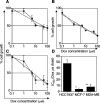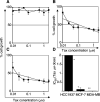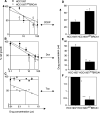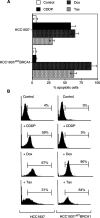BRCA1 expression modulates chemosensitivity of BRCA1-defective HCC1937 human breast cancer cells
- PMID: 12698198
- PMCID: PMC2747554
- DOI: 10.1038/sj.bjc.6600859
BRCA1 expression modulates chemosensitivity of BRCA1-defective HCC1937 human breast cancer cells
Abstract
Germline mutations of the tumour suppressor gene BRCA1 are involved in the predisposition and development of breast cancer and account for 20-45% of all hereditary cases. There is an increasing evidence that these tumours are characterised by a specific phenotype and pattern of gene expression. We have hypothesised that differences in chemosensitivity might parallel molecular heterogeneity of hereditary and sporadic breast tumours. To this end, we have investigated the chemosensitivity of the BRCA1-defective HCC1937 breast cancer cell line, and the BRCA1-competent MCF-7 (hormone-sensitive) and MDA-MB231 (hormone-insensitive) breast cancer cell lines using the MTT assay. The 50% inhibitory concentration (IC(50)) for the individual compounds were derived by interpolate plot analysis of the logarithmic scalar concentration curve after a 48 h exposure. HCC1937 cells were significantly (P<0.005) more sensitive to cisplatin (CDDP) (IC(50) : 30-40 microM) compared with MCF-7 (IC(50) : 60-70 microM) and MDA-MB231 (IC(50) : 90-100 microM) cells. On the other hand, BRCA1-defective breast cancer cells were significantly less sensitive to doxorubicin (Dox) (IC(50) : 45-50 microM) compared with MCF-7 (IC(50) : 1-5 microM) and MDA-MB231 (IC(50) : 5-10 microM) (P<0.02), as well as to paclitaxel (Tax) (IC(50) : >2 microM for HCC1937, 0.1-0.2 microM for MCF-7 and 0.01-0.02 microM for MDA-MB231) (P<0.001). Full-length BRCA1 cDNA transfection of BRCA1-defective HCC1937 cells led to the reconstituted expression of BRCA1 protein in HCC1937/(WT)BRCA1-derived cell clone, but did not reduce tumour cell growth in soft agar. BRCA1 reconstitution reverted the hypersensitivity to CDDP (P<0.02), and restored the sensitivity to Dox (P<0.05) and Tax (P<0.001), compared with parental HCC1937 cells. Taken together, our findings suggest a specific chemosensitivity profile of BRCA1-defective cells in vitro, which is dependent on BRCA1 protein expression, and suggest prospective preclinical and clinical investigation for the development of tailored therapeutical approaches in this setting.
Figures






References
-
- Abbott DW, Thompson ME, Robinson-Benion C, Tomlinson G, Jensen RA, Holt JT (1999) BRCA1 expression restores radiation resistance in BRCA1-defective cancer cells through enhancement of transcription-coupled DNA repair. J Biol Chem 274: 18808–18812 - PubMed
-
- Andrews HN, Mullan PB, McWilliams S, Sebelova S, Quinn JE, Gilmore PM, McCabe N, Pace A, Koller B, Johnston PG, Haber DA, Harkin DP (2002) BRCA1 regulates the interferon gamma mediated apoptotic response. J Biol Chem 277: 26225–26232 - PubMed
-
- Bhattacharyya A, Ear US, Koller BH, Weichselbaum RR, Bishop DK (2000) The breast cancer susceptibility gene BRCA1 is required for subnuclear assembly of Rad51 and survival following treatment with the DNA cross-linking agent cisplatin. J Biol Chem 275: 23899–23903 - PubMed
-
- Bochar DA, Wang L, Beniya H, Kinev A, Xue Y, Lane WS, Wang W, Kashanchi F, Shiekhattar R (2000) BRCA1 is associated with a human SWI/SNF-related complex: linking chromatin remodeling to breast cancer. Cell 102: 257–265 - PubMed
-
- Brodie SG, Xu X, Qiao W, Li WM, Cao L, Deng CX (2001) Multiple genetic changes are associated with mammary tumorigenesis in Brca1 conditional knockout mice. Oncogene 20: 7514–7523 - PubMed
Publication types
MeSH terms
Substances
LinkOut - more resources
Full Text Sources
Other Literature Sources
Miscellaneous

